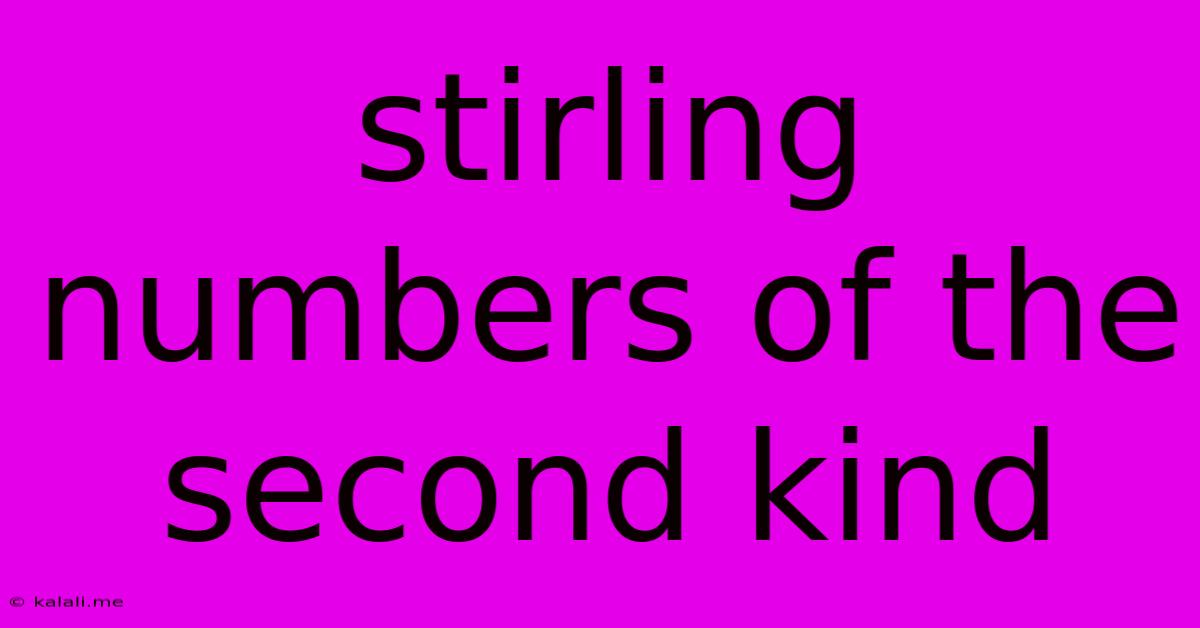Stirling Numbers Of The Second Kind
Kalali
May 26, 2025 · 3 min read

Table of Contents
Stirling Numbers of the Second Kind: A Deep Dive
Stirling numbers of the second kind, often denoted as S(n, k) or {n \atop k}, represent the number of ways to partition a set of n objects into k non-empty subsets. Understanding these numbers is crucial in combinatorics and has applications in various fields, from probability and statistics to computer science. This article will explore their definition, properties, and some practical examples.
What are Stirling Numbers of the Second Kind?
Imagine you have n distinct objects and you want to divide them into k non-empty groups. The number of ways you can do this is given by the Stirling number of the second kind, S(n, k). It's important to note that the order of the groups doesn't matter, and neither does the order of the objects within each group. For example, S(3, 2) = 3 because there are three ways to partition a set of three objects into two non-empty subsets: {1, 2}{3}, {1, 3}{2}, and {2, 3}{1}.
Key Properties and Formulas
Several important properties and formulas govern Stirling numbers of the second kind:
-
Recursive Formula: A fundamental recursive relationship allows for calculation:
S(n, k) = k * S(n-1, k) + S(n-1, k-1)
This formula states that we can either add the nth object to one of the existing k subsets (k * S(n-1, k)) or create a new subset containing only the nth object (S(n-1, k-1)).
-
Explicit Formula: While the recursive formula is useful for computation, an explicit formula also exists:
S(n, k) = (1/k!) * Σ_{j=0}^{k} (-1)^{k-j} * (k choose j) * j^n
This formula involves a summation and binomial coefficients, offering a direct calculation method, although it can be computationally expensive for larger values of n and k.
-
Boundary Conditions:
- S(n, 0) = 0 for n > 0 (There's no way to partition a non-empty set into zero subsets)
- S(n, 1) = 1 for n ≥ 1 (There's only one way to partition a set into one subset)
- S(n, n) = 1 for n ≥ 0 (There's only one way to partition a set into n singleton subsets)
- S(n, k) = 0 for k > n (You can't partition n objects into more than n subsets)
Relationship to Bell Numbers
Stirling numbers of the second kind are closely related to Bell numbers, denoted as B<sub>n</sub>. The Bell number B<sub>n</sub> represents the total number of partitions of a set of n objects into any number of non-empty subsets. The relationship is:
B<sub>n</sub> = Σ_{k=0}^{n} S(n, k)
In essence, the Bell number is the sum of all Stirling numbers of the second kind for a given n.
Applications of Stirling Numbers of the Second Kind
Stirling numbers of the second kind find applications in diverse areas:
- Combinatorics: Counting partitions of sets, which is fundamental to various combinatorial problems.
- Probability and Statistics: Analyzing probability distributions and calculating moments of random variables.
- Computer Science: Analyzing algorithms and data structures involving set partitioning.
- Physics: In certain statistical mechanics problems.
Conclusion
Stirling numbers of the second kind provide a powerful tool for solving problems involving the partitioning of sets. Their recursive and explicit formulas, along with their relationship to Bell numbers, allow for efficient calculation and application in various fields. Understanding these numbers is a crucial step in mastering advanced combinatorial techniques. Further exploration into generating functions and their connections to other mathematical concepts can deepen your understanding of their significance.
Latest Posts
Latest Posts
-
How Far Is 0 4 Miles To Walk
Jul 12, 2025
-
What Is 20 Percent Of 800 000
Jul 12, 2025
-
Words That Start With Y In Science
Jul 12, 2025
-
Prevent An Expressway Emergency By Merging Without
Jul 12, 2025
-
How Many Grams Of Sugar In A Pound
Jul 12, 2025
Related Post
Thank you for visiting our website which covers about Stirling Numbers Of The Second Kind . We hope the information provided has been useful to you. Feel free to contact us if you have any questions or need further assistance. See you next time and don't miss to bookmark.